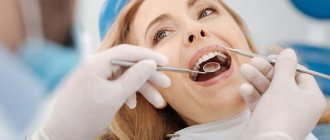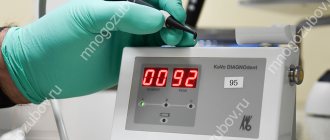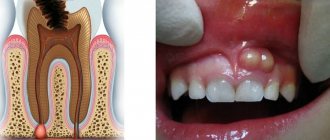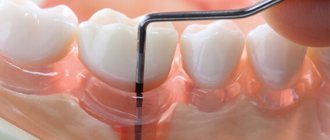A periodontal abscess is an acute purulent inflammation of the gums. A complex pathology in which a purulent sac forms inside the periodontium, which in size can reach the size of a walnut. When a bladder filled with purulent contents ruptures, blood poisoning can occur and the infection can spread throughout the body. That is why it is important to promptly seek help from a specialist who will diagnose the disease, prescribe adequate treatment and prevent relapses.
What is a gum abscess, definition of the disease
Let us consider in more detail what an abscess on the gum is and the mechanism of its occurrence. A purulent focus occurs as a result of long-term untreated inflammation of periodontal tissues. The pathogenesis of the disease is associated with the penetration of pathogenic microorganisms (mainly Bacteroides forsythus and Porphyromonas gingivalis) into the periodontal tissues. Possible routes of penetration of microbes:
- from the outside: through a carious cavity, chips, cracks on the surface of the segment;
- from the inside (hematogenously, lymphogenously): in the presence of other septic foci in the body.
During their life, bacteria produce toxic substances that lyse tissue cells, resulting in the formation of a cavity filled with pus. The abscess under the tooth is surrounded by a connective tissue capsule, which separates it from the intact periodontal tissues.
Microbial metabolic products have a neurotoxic effect on nerve receptors located in the pulp of the segment, which causes pain. In addition, they increase the permeability of the capillary walls, resulting in swelling of the surrounding tissues.
METROGYL DENTA® for periodontal abscess
METROGYL DENTA® has antibacterial activity and helps relieve inflammation caused by pathogenic microorganisms. The gel can be used to treat periodontal abscess in the postoperative period. Before using the drug, you must brush your teeth. Then a small amount of gel is carefully applied to the affected area of the gum using a cotton swab. The duration of action of the drug is 30 minutes; during this period you should refrain from drinking and eating. The duration of treatment is on average 7-10 days. Before using METROGYL DENTA®, we recommend consulting with your dentist.
Up to contents
The information in this article is for reference only and does not replace professional advice from a doctor. To make a diagnosis and prescribe treatment, consult a qualified specialist.
Causes of gum abscess
The human oral cavity contains about 30 strains of microorganisms, represented by more than 700 species of bacteria. Under normal conditions, microbiocenosis does not harm its owner. A dental abscess occurs only in the presence of certain factors:
- traumatic disruption of the periodontal junction;
- infectious dentogingival pathologies;
- transmission of microorganisms through the bloodstream from other infectious foci (meningitis, pneumonia, tonsillitis, etc.);
- gum damage during segment therapy;
- trauma to the crown or root of the unit;
- peri-implantitis (inflammation around the implanted tooth root).
The likelihood of developing the disease increases with poor oral care, hypothermia, accumulation of tartar inside deep periodontal pockets, and smoking. Professional hygiene and gum treatment in Moscow is carried out by doctors of the North-Eastern Dental Center No. 1. A timely visit to the clinic will reduce the risk of the formation of a purulent formation.
Prevention
- Thorough dental hygiene: brushing your teeth in the morning and evening, rinsing your mouth after every meal, using various devices: dental floss, brushes. If there are dentures in the mouth, it is recommended to clean them of food debris using an irrigator - a special device that supplies water under pressure.
- Timely treatment of diseases of teeth and gums.
- Preventative dental examinations are necessary at least 2 times a year to assess the condition of the teeth and oral cavity. If there is hard dental plaque, use hardware teeth cleaning.
Symptoms of gum abscess
Gingival abscess manifests itself in two types of symptoms: local and general clinical. Local symptoms are caused by reactive manifestations in the area of inflammation. The appearance of general symptoms is associated with intoxication of the body. The main symptomatic manifestations of the disease:
| Local inflammatory reaction | Symptoms of intoxication |
| pain when pressing on the affected unit; hyperemia of the gums over the area of inflammation; swelling of the tissue around the abscess; smell of rot from the mouth; violation of facial configuration; formation of a tubercle with purulent contents near the tooth; increased mobility of the diseased unit; darkening of tooth enamel; enlargement of nearby lymph nodes. | hyperthermia; dyspnea; cranialgia; violation of orientation in space; tachycardia; aching joints; lethargy; drowsiness; irritability. |
The leading symptom of an abscess is pain. It can be fixed only at the point of inflammation, but more often the discomfort radiates to the head, auricle, eye socket, neck, and neighboring segments. Soreness has different intensity, character (sharp, shooting, dull), occurs periodically in response to stress factors, or is constantly present.
Causes
The main cause of periodontal abscess is infection in the gum pockets, resulting in the development of purulent inflammation of the soft tissues around the tooth.
The following factors contribute to the appearance of periodontal abscess:
- Gum diseases: gingivitis, periodontitis, periodontal disease.
- Injury to the soft tissue around the tooth by hard food or a crown.
- A foreign body gets into the gum pocket (the space between the tooth and gum): a piece of food, bristles from a toothbrush.
- Tooth diseases: caries, pulpitis.
Stages of development and classification of gum abscess
A gum abscess most often has an acute course, characterized by a clear clinical picture with increasing pain and swelling. Sometimes, in the absence of treatment, the process may subside, the clinic becomes weakly expressed and erased. This means that the abscess has become chronic.
Depending on the location of the purulent focus, several types of pathology are distinguished:
- Periodontal abscess. Localized inside the hypertrophied periodontal pocket (between the alveolar process and the gum). The cause of the pathology is subgingival deposits, which are a breeding ground for the proliferation of bacteria.
- Periapical (root). The leading cause of occurrence is inadequate root canal treatment, leading to periodontal inflammation. Granulations form near the root apex. Progressive inflammation spreads to the periosteum and periodontal tissue. A connective tissue capsule with purulent contents is formed. Over time, a fistula forms with pus coming to the surface in the form of a lump.
- Desnevoy. The purulent cavity is located near the papillae between the segments. A possible cause is an injection into the gum.
Main forms of periodontal abscesses
- Acute – characterized by pronounced clinical manifestations and a sharp increase in pain. Deep periodontal pockets are diagnosed in the oral cavity, individual teeth become mobile, and the person feels a general malaise.
- Chronic – the disease occurs with “erased” symptoms. The gums begin to bleed, the ulcers become more voluminous and dense, and the roots of the teeth become exposed.
Note! Sometimes a periodontal abscess may go away on its own, but this does not mean that the patient has cured on their own. The process can become chronic, poisoning the body with decay products of soft tissues.
Depending on the location of the purulent sac, the following types of abscesses are distinguished:
- basal;
- apical;
- cervical.
Stages of development of gum abscess
| Disease stage | Description |
| Initial | The beginning of inflammation. If the immune system is functioning well, the process may stop on its own. Symptoms are absent or mild. If the immune defense is insufficient, bone or soft tissue begins to melt. Hyperemia of the mucous membrane and discomfort appear. |
| Subacute | The inflammatory process intensifies. Pus accumulates in the pathological area (near the root, inside the periodontal pocket, near the gingival papilla). The pain intensifies. The tooth reacts to irritation. |
| Acute | Progression leads to abscess formation: a cavity with pus forms in the central zone of infiltration. The clinical picture is clearly expressed: the pain is constant, sharp, swelling appears. A lump appears on the surface of the gum, inside of which there is purulent exudate. Inflammation spreads to the submandibular lymph nodes. |
| Chronic | The abscess on the gum spontaneously opens and the contents of the cavity come out. Signs of acute inflammation subside. |
Kinds
Dental inflammatory disease, accompanied by swelling and accumulation of purulent exudate, is divided into two categories according to its nature and course.
- Spicy. The disease has a pronounced clinical character. Pathological mobility of elements of the dental system and the formation of deep periodontal pockets are diagnosed. The patient experiences severe pain, malaise, fever, and deterioration in general health.
- Chronic. Painful condition of the gums, bleeding, filling of pockets with a purulent component with a certain frequency. When diagnosing, exposure of the roots of the molars and swelling of the gums may be detected. The patient experiences increased sensitivity to external stimuli.
When opening a periodontal abscess, the localization can be established both in the cervical area and in the apical part of the molar or canine. At this clinic, deep pathological pockets and hard subgingival deposits are recorded. In case of a chronic disease, exacerbation is observed in the autumn-spring period with a sharp change in temperature and immunodeficiency.
Complications that a gum abscess can cause
Without treatment of the disease and inadequate medical care, complications may develop. Adverse consequences arise due to the spread of inflammation to neighboring organs and tissues, as well as the spread of infection throughout the body with the formation of secondary septic foci. The most common pathological conditions that occur are:
- lymphadenitis - infection of the lymph nodes;
- sinusitis - infection in the maxillary sinuses;
- periostitis of the jaw (inflammation of the periosteum);
- osteomyelitis of the jaw bones (destruction of bone tissue due to purulent-necrotic melting of osteocytes);
- phlegmon - diffuse odontogenic inflammation of soft tissues, accompanied by progressive swelling of the face;
- destruction of the alveolar processes with significant loosening of teeth or their loss;
- peri-implantitis with implant rejection;
- sepsis.
Purulent lesions of soft periodontal tissues are always accompanied by general intoxication of the body. The temperature rises and chills appear. There is a headache, tachycardia, and the pulse quickens. Pain relief with medications brings short-term relief, but symptoms return after the medication wears off.
Treatment of gum abscess
Treatment of the disease is aimed at solving two main problems:
| Type of treatment | Methods |
| Symptomatic treatment of inflammation and pain syndrome | removal of an abscess on the gum (dissection, installation of drainage for the outflow of pus); antibiotic therapy (penicillins, fluoroquinolones, macrolides). Prescribed to stop the infectious process; NSAIDs (Diclofenac, Indomethacin, Ibuprofen, etc.). Eliminate pain and inflammation; antiseptics (Chlorhexidine, Miramistin). Used in the form of rinses and gum baths for antiseptic treatment of the oral cavity. |
| Etiotropic treatment (elimination of the cause of pathology) | tooth extraction. Carry out when it is impossible to implement tooth-preserving measures; repeated endodontic treatment (opening of canals and their refilling); professional teeth cleaning to remove mineral and soft plaque; removal of the artificial root (for peri-implantitis). |
An abscess on the gum is a serious dental pathology. If treatment is not started in time, the process continues to develop and leads to adverse consequences. To avoid complications, at the first signs of inflammation you should make an appointment with the dentist. ]dentistry in Otradnoye[/anchor] offers assistance in eliminating problems with diseased teeth and periodontal disease.
Acute periapical abscess
It is easiest to deal with visible sources of infection, but acute periapical abscess is very dangerous, since it is almost impossible to notice at an early stage of formation. In this case, the infection begins, literally, from the inside. The infection remaining in the tooth under a filling or in canals with dead pulp after insufficient treatment begins to spread through the roots of the tooth and alveolar bone to adjacent soft tissues. In this case, it is possible to identify the problem before the formation of an abscess or acute pain only with the help of photo X-rays or magnetic resonance imaging (MRI).









